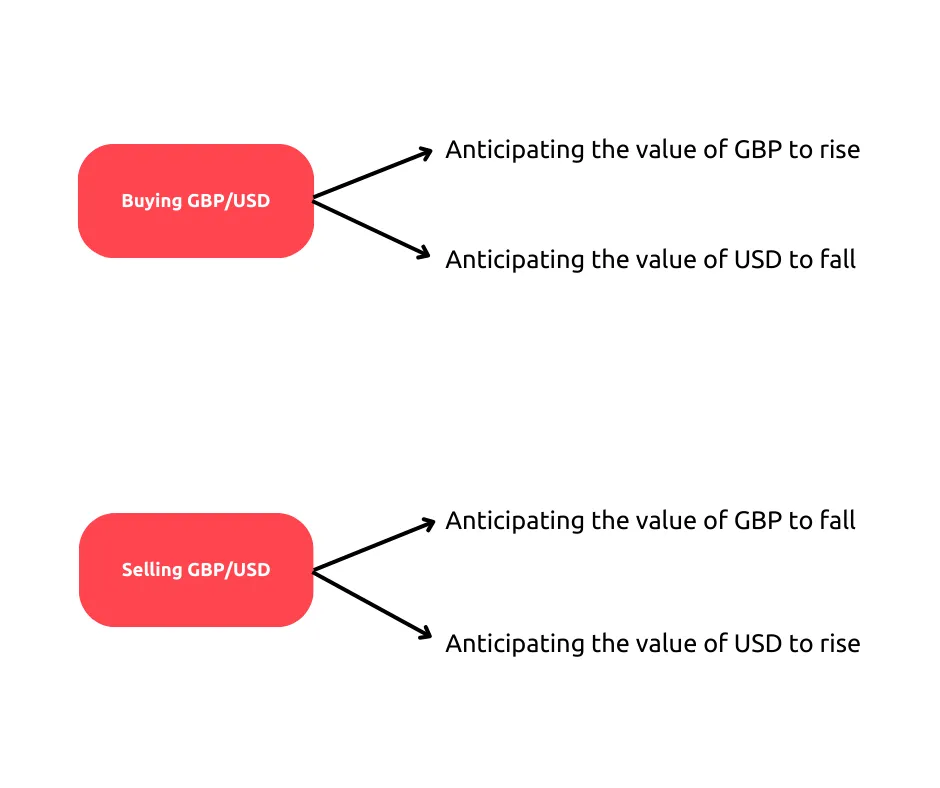A guide on forex currency pairs

All transactions that take place on the foreign exchange market (also known as the forex market) involve currency pairs. Currency pairs refer to the 2 currencies that are traded against each other, and the value of these pairs reflects the current forex rates.
Currency pairs 101
Forex currency pairs compare 2 currencies, where the value of the first currency, also known as the base currency, is quoted against the second currency, or quote currency.
If you’re familiar with exchanging money when travelling, think of your local currency as the base currency and the foreign currency as the quote currency.
In the forex market, each currency in the forex market uses a unique three-letter code assigned to them by the International Organisation for Standardisation (ISO), referred to as an ISO currency code. For example, the US dollar has the ISO code USD, while the British pound sterling is noted as GBP.
Deciphering forex currency pairs
When trading on the forex market, your trade position will be determined by the currency exchange rates of both currencies in a currency pair.
Let’s take, for instance, the currency pair of GBP and USD. When you trade on this pair, you will have two different values – GBP/USD and USD/GBP.
In the GBP/USD pair, GBP is the base currency, and USD is the quote currency. Each pair has a direct exchange rate and an indirect exchange rate.
- Direct exchange rate: Direct exchange rates are where the cost of one unit of base currency is given in units of the quote currency.
For instance, if GBP/USD pair has a direct exchange rate of 1 GBP = 1.11 USD, it means one British pound can buy 1.11 US dollars.
- Indirect exchange rate: Indirect exchange rates are where the cost of one unit of quote currency is given in units of the base currency.
Using the same example above, if the GBP/USD pair has an indirect exchange rate of 1 USD = 0.90 GBP, one US dollar would be able to buy 0.90 British pounds.
Taking the earlier example of exchanging local and foreign currency, direct exchange would occur when you’re exchanging your local currency for foreign currency, and indirect exchange would be when you’re exchanging foreign currency for local currency.
Trying your hand at trading forex currency pairs
In forex trading, it is assumed that you are buying a currency pair with the expectation of its base currency value going up, and selling a currency pair with the expectation that the base currency's value will decline.
If you buy the GBP/USD pair, it can be said that you anticipate that 1 GBP is going to be worth more than its current value, while the value of USD stays the same or declines. Similarly, if you were to trade this pair by selling, it would be implied that you’re speculating the GBP’s value will fall against the USD and would like to sell it off before the price dips even further.

For instance, say GBP/USD was trading at 1.25 USD, and you decide to buy 1 GBP.
If the price of GBP/USD rises from 1.25 USD to 1.30 USD per 1 GBP, the USD would be said to have depreciated in value, and the GBP would have appreciated in value – as you would now need more USD to buy the same amount of GBP.
However, if the price of GBP/USD falls from 1.25 USD to 1.20 USD, the USD would have strengthened in value, and the GBP would have weakened in value as you would need fewer units of USD to buy the same amount of GBP.
There are multiple factors that affect forex rates, leading to the fluctuation of currency pair prices.
Now that you know how forex currency pairs work, trade forex pairs on CFDs, options, and multipliers on Deriv. Choose from a variety of major, minor, exotic, and micro forex pairs on our various platforms. Want to put your newfound knowledge to the test? Trade risk-free on our free demo account, which comes preloaded with 10,000 USD.
Disclaimer:
The information contained within this blog article is for educational purposes only and is not intended as financial or investment advice.
Options trading and exotic and minor pairs are unavailable to clients residing within the European Union.





